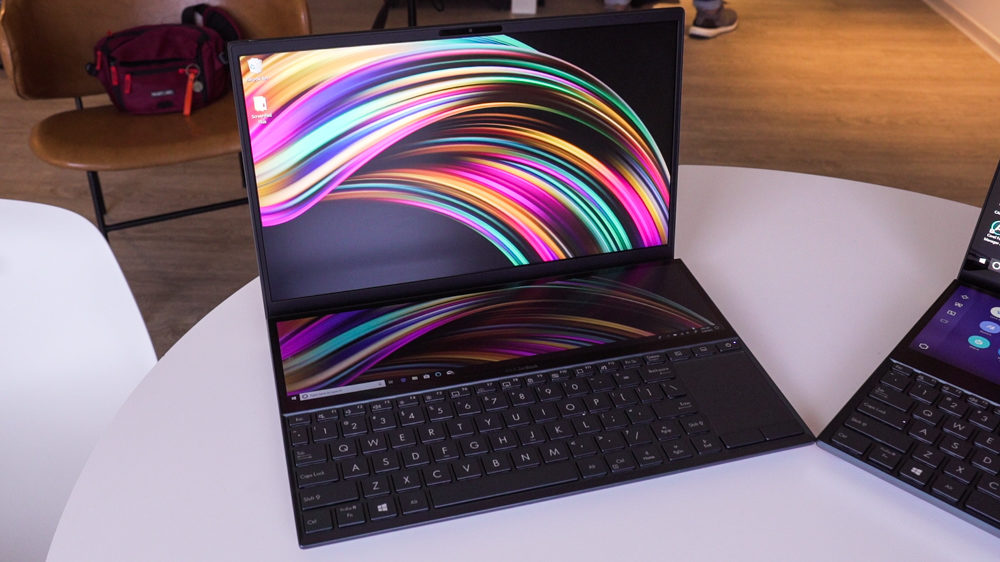ASUS has finally launched its latest devices in Taiwan during Computex 2019 and the company did not disappoint when it came to presenting its next generation of innovations for their laptops. Their main highlight this year is the ZenBook Pro Duo and its non-pro variant. These ultrabooks are not like its predecessors as it features a secondary screen below the main display. Fortunately, I got the chance to test out this device, check it out!

The ZenBook Pro Duo and its sibling look like any ordinary ASUS ultrabook device. It has an aluminum chassis, thin body, and most importantly, a premium look. That’s the initial look when you haven’t opened it yet. However, its game-changing design is showcased when you open the lid.

At first glance, you will unconsciously feast your eyes on the rectangular screen located at the body of the device. ASUS dubs this as the ScreenPad Plus with a 14-inch 4K UHD display for the ZenBook Pro Duo, while its smaller sibling has 12.6-inch FHD screen. Let’s talk more about what it can do in a bit.

Starting at the front, you’ll see the 15.6-inch OLED 4K display for the ZenBook Pro while the non-pro variant has a 14-inch with only FHD resolution. You’ll also see that both have very thin bezels, something that ASUS basically has mastered already, given their history with ultrabooks. Up top is a webcam which is always a welcomed component even in 2019.

Looking to the left, you’ll notice that it has an elevated body, helping heat dissipation reduce the thermal problems that its predecessors had. For the ZenBook Pro Duo, you can see the charging port, HDMI port, USB 3.1 Gen 2 Type-A port, and the loudspeaker. Underneath is the exhaust vent, another welcomed sight as it will have uninterrupted heat dissipation.

You can find another USB 3.1 Gen 2 Type-A port, 3.5mm audio port, another loudspeaker – exhaust vent combo, LED notification lights, and USB Type-C thunderbolt 3 port.

For the first time in the ASUS ZenBook family, the keyboard and trackpad are located at the bottom part. It’s a placement that’s been adopted from the ROG Zephyrus devices. Both variants have a TKL setup and they have the same good tactility. The ZenBook Pro Duo has a virtual numpad while the ZenBook Duo doesn’t have any and it also has physical left and mouse buttons.


Now that I’ve mentioned almost all the ultrabooks’ components, let’s move to the main event of this device, the ScreenPad Plus. This feature is basically an extension for your main display. If we put it in a perspective, the ZenBook Duo series has more than 100% screen-to-body ratio already which is really refreshing to see.

There’s a lot of use for this feat as you can have three multiple applications automatically sized simultaneously. For streamers, they can use the ScreenPad Plus as a means to set up a full streaming kit with OBS (streaming app), Stream Chat, and socials opened here without having no interruptions when they are playing.

I also noticed that when you watch videos on YouTube, the full-screen function doesn’t cover the whole display and keeps the video at a uniform ratio.

When it comes to productivity, this is actually a great tool for creators, especially with its powerful performance. Powering the ZenBook Pro Duo is an NVIDIA RTX 2060 (6GB) graphics, Intel Core i9-9980HK or i7-9750H processor, up to 32GB of RAM, and 1TB PCIe x4 or 512GB/256GB PCIe x2 SSD. For ZenBook Duo it comes with an NVIDIA MX250 (2GB), up to 16GB of RAM, with the same storage setup.

Overall, the ASUS ZenBook Duo and Pro Duo both feel solid, premium, and lightweight. It definitely is a unique ultrabook thanks to the addition of the ScreenPad Plus which makes it very appealing to get. I can’t wait to test out its full capabilities so stay tuned for that!


YugaTech.com is the largest and longest-running technology site in the Philippines. Originally established in October 2002, the site was transformed into a full-fledged technology platform in 2005.
How to transfer, withdraw money from PayPal to GCash
Prices of Starlink satellite in the Philippines
Install Google GBox to Huawei smartphones
Pag-IBIG MP2 online application
How to check PhilHealth contributions online
How to find your SIM card serial number
Globe, PLDT, Converge, Sky: Unli fiber internet plans compared
10 biggest games in the Google Play Store
LTO periodic medical exam for 10-year licenses
Netflix codes to unlock hidden TV shows, movies
Apple, Asus, Cherry Mobile, Huawei, LG, Nokia, Oppo, Samsung, Sony, Vivo, Xiaomi, Lenovo, Infinix Mobile, Pocophone, Honor, iPhone, OnePlus, Tecno, Realme, HTC, Gionee, Kata, IQ00, Redmi, Razer, CloudFone, Motorola, Panasonic, TCL, Wiko
Best Android smartphones between PHP 20,000 - 25,000
Smartphones under PHP 10,000 in the Philippines
Smartphones under PHP 12K Philippines
Best smartphones for kids under PHP 7,000
Smartphones under PHP 15,000 in the Philippines
Best Android smartphones between PHP 15,000 - 20,000
Smartphones under PHP 20,000 in the Philippines
Most affordable 5G phones in the Philippines under PHP 20K
5G smartphones in the Philippines under PHP 16K
Smartphone pricelist Philippines 2024
Smartphone pricelist Philippines 2023
Smartphone pricelist Philippines 2022
Smartphone pricelist Philippines 2021
Smartphone pricelist Philippines 2020
Julia says:
When is this available in the Philippines?